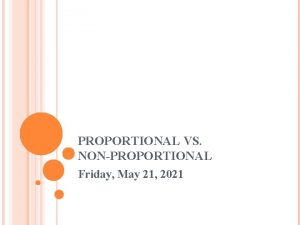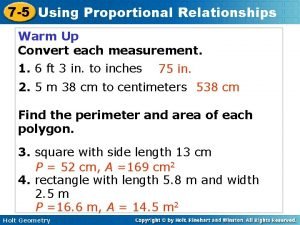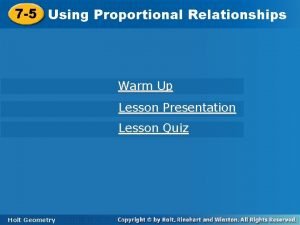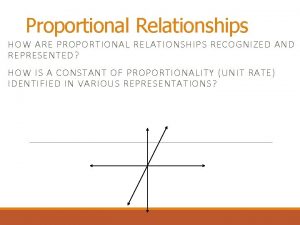7 5 Using Proportional Relationships Warm Up 1



- Slides: 3

7 -5 Using Proportional Relationships Warm Up 1. Convert each measurement a. 6 ft 3 in. to inches b. 5 m 38 cm to centimeters 2. Find the area and perimeter of a square with sides of length 13 cm. 3. Find the area and perimeter of a rectangle with sides of 5. 8 m & 2. 5 m. LEARNING GOALS – LESSON 7: 5 7. 5. 1: Use ratios to make indirect measurements. 7. 5. 2: Use scale drawings to solve problems. 7. 5. 3: Use rations to find perimeter and area _______ measurement is any method that uses: • • Example 1: Measurement Application A. This here is a picture of Larry claims that the fish he caught were a total of 6. 5 ft in length! If Larry is actually 5’ 11”, use indirect measurement to determine if he is fibbing.

7 -5 Using Proportional Relationships A ______ drawing represents an object as smaller than or larger than its actual size. The drawing’s scale is the ______ of any length in the drawing to the corresponding actual length. Example 2 A: Solving for a Dimension A. On a Wisconsin road map, Kristin measured a distance of 11⅛ in. from Madison to Wausau. The scale of this map is 1 inch: 13 miles. What is the actual distance between Madison and Wausau to the nearest mile? B. Find the actual distance between City Hall and El Centro College. Example 2 B: Making a Scale Drawing The rectangular central chamber of the Lincoln Memorial is 70 ft long and 60 ft wide. Make a scale drawing of the floor of the chamber using a scale of 1 in. : 20 ft.

7 -5 Using Proportional Relationships Example 3: Using Ratios to Find Perimeters and Areas A. Given that ∆LMN ~ ∆QRT, find the perimeter P and area A of ∆QRS. B. ∆ABC ~ ∆DEF, BC = 4 mm, and EF = 12 mm. If P = 42 mm and A = 96 mm 2 for ∆DEF, find the perimeter and area of ∆ABC.





